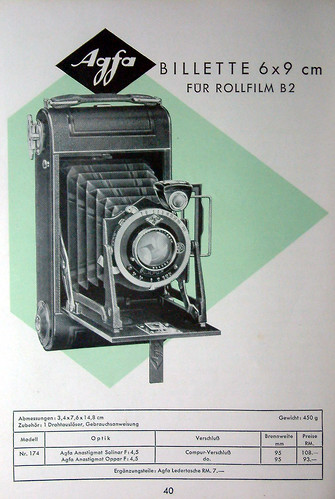Difference between revisions of "Billette"
m (Added focal length) |
Hanskerensky (talk | contribs) (Added link to information page) |
||
| (2 intermediate revisions by 2 users not shown) | |||
| Line 1: | Line 1: | ||
| − | {{ | + | <div class="floatright plainlinks" style="margin:0px 0px 20px 20px;"> |
| + | {{Flickr_image | ||
| + | |image_source= https://www.flickr.com/photos/century_graphic/18879405319/in/pool-camerawiki/ | ||
| + | |image= http://farm1.staticflickr.com/526/18879405319_655b4b830e.jpg | ||
| + | |image_align= | ||
| + | |image_text= Billette in the brochure ''Die Agfa Photographie'', early '30s<br/> | ||
| + | |image_by= | ||
| + | |scan_by=Dustin McAmera | ||
| + | |image_rights= pd | ||
| + | }} | ||
| + | </div> | ||
The '''Billette''' is a metal-bodied folding camera for 6x9 cm exposures on 120 roll-film (Agfa size B2), made by [[Agfa]] in the 1930s. | The '''Billette''' is a metal-bodied folding camera for 6x9 cm exposures on 120 roll-film (Agfa size B2), made by [[Agfa]] in the 1930s. | ||
| Line 10: | Line 20: | ||
That is, an entry-level specification, two expensive cosmetic variations on it, and one high-specification camera. The illustration shows a camera with the Billy's two-point ('near' and 'far') focusing control, and only a brilliant finder. | That is, an entry-level specification, two expensive cosmetic variations on it, and one high-specification camera. The illustration shows a camera with the Billy's two-point ('near' and 'far') focusing control, and only a brilliant finder. | ||
| − | In another, German brochure, | + | In another, German brochure, somewhat later in the 1930s (but not much; the brochure still lists the [[Agfa Standard|Standard]] cameras, discontinued in the mid-30s) the Billette is a distinctly better-specified camera than the Billy. Whereas the Billy models still have two-point focusing, the Billette (as illustrated here) now has front-element scale focusing, though still with 'near' and 'far' positions marked in the focusing scale.<ref name=AP>''Die Agfa Photographie'': Agfa brochure, undated but clearly of the early 1930s (the Standard cameras are still listed in all but the largest size), and not before 1931 (the camera previously named the [[Agfa Billy Jgetar 8.8]] has been redesignated the Billy I)</ref> The camera is only offered with a rim-set [[Compur]] shutter and either an f/4.5 Solinar or an f/4.5 Oppar (also seen on the [[Karat#Karat 4.5|Karat 4.5]], but not on many other cameras, if any); either is a 95 mm lens. Oddly, both of these lenses are Tessar-formula anastigmats, seemingly offering little difference in specification or in price: as shown in the illustrated page, the camera with the Solinar is listed at a price of 108 Marks, compared to 93 Marks with the Oppar. The camera has a frame finder as well as a brilliant finder. It weighs 450 grams. |
| − | |||
==Notes== | ==Notes== | ||
<references/> | <references/> | ||
| + | ==Links== | ||
| + | *[https://www.udospickmann.de/kopie-von-agfa-ventura Agfa Billette page] at [https://www.udospickmann.de/ Udo Spickmann] (in German) | ||
[[Category:German 6x9 viewfinder folding]] | [[Category:German 6x9 viewfinder folding]] | ||
| − | [[Category:Agfa]] | + | [[Category:Agfa|Billette]] |
| + | [[Category:B|Billette Agfa]] | ||
| + | [[Category:120 film]] | ||
Latest revision as of 04:45, 14 June 2023

|
| Billette in the brochure Die Agfa Photographie, early '30s scanned by Dustin McAmera (Image rights) |
The Billette is a metal-bodied folding camera for 6x9 cm exposures on 120 roll-film (Agfa size B2), made by Agfa in the 1930s.
The place of the Billette in Agfa's range is curious. Collection Appareils shows the camera in a page from a French catalogue dated to 1931.[1] It is described as Agfa's latest product, and also as the 'younger sister' of the Billy. In this catalogue, the Billette is offered with an odd range of specifications:
- f/7.7 Igestar (Agfa's cheapest lens) and Automat shutter to 1/100 second (priced at 295 francs);
- the same specification, but with coloured leatherette (385 fr)
- the same, but with crocodile-skin finish and plated (not painted) fittings (575 fr)
- 'Modèle de grande luxe': f/4.5 Solinear and Compur shutter, and black morocco leather finish (875 fr).
That is, an entry-level specification, two expensive cosmetic variations on it, and one high-specification camera. The illustration shows a camera with the Billy's two-point ('near' and 'far') focusing control, and only a brilliant finder.
In another, German brochure, somewhat later in the 1930s (but not much; the brochure still lists the Standard cameras, discontinued in the mid-30s) the Billette is a distinctly better-specified camera than the Billy. Whereas the Billy models still have two-point focusing, the Billette (as illustrated here) now has front-element scale focusing, though still with 'near' and 'far' positions marked in the focusing scale.[2] The camera is only offered with a rim-set Compur shutter and either an f/4.5 Solinar or an f/4.5 Oppar (also seen on the Karat 4.5, but not on many other cameras, if any); either is a 95 mm lens. Oddly, both of these lenses are Tessar-formula anastigmats, seemingly offering little difference in specification or in price: as shown in the illustrated page, the camera with the Solinar is listed at a price of 108 Marks, compared to 93 Marks with the Oppar. The camera has a frame finder as well as a brilliant finder. It weighs 450 grams.
Notes
- ↑ Billette; page from a Photo-Plait catalogue of 1931, at Collection Appareils.
- ↑ Die Agfa Photographie: Agfa brochure, undated but clearly of the early 1930s (the Standard cameras are still listed in all but the largest size), and not before 1931 (the camera previously named the Agfa Billy Jgetar 8.8 has been redesignated the Billy I)
Links
- Agfa Billette page at Udo Spickmann (in German)